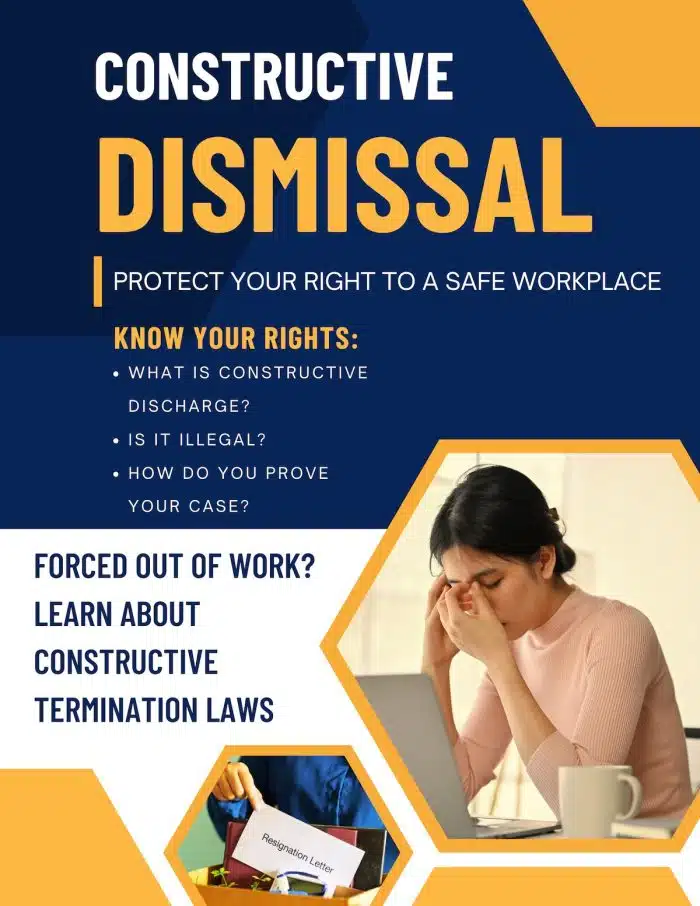Guide To Constructive Discharge: How to Prove Forced Resignation
February 18, 2025
By Genevieve Carlton, Ph.D
Charles Joseph draws on decades of employment law experience to help you understand what evidence you need to prove workplace discrimination.

What is constructive discharge? Also known as constructive termination or constructive dismissal, constructive discharge means your employer forced you to resign. Forced resignation can violate your rights.
Proving constructive termination isn’t easy. Would a reasonable employee feel like they had no choice but to quit their job? That could count as constructive termination. But the legal definition of constructive discharge depends on your state and how courts interpret the law.
Employment attorney Charles Joseph weighs in on how to prove constructive discharge.
What is Constructive Discharge?
What is constructive discharge? And what’s the difference between constructive discharge and wrongful termination?
Wrongful termination and constructive discharge both involve an employer losing their job. In wrongful termination cases, the employer fires the employee. In constructive discharge cases, the employee quits their job.
Both are illegal if the employee experienced workplace violations that led to the termination of their job. “Constructive discharge” means that the worker’s resignation was not voluntary – they quit to escape harassment, discrimination, or another violation of their rights.
Learn more about wrongful termination with our Wrongful Termination FAQ and our guide on Wrongful Termination vs. Unfair Dismissal.
Is Constructive Dismissal Illegal?
Constructive termination is illegal. Employers cannot create a hostile work environment that forces employees to leave to protect themselves.
If an average person would run screaming from the job, you may be able to claim constructive termination.-Charles Joseph, NYC Employment Attorney
If conditions are so bad that a reasonable person would have no alternative but to quit their job, their resignation is considered forced.
What counts as a hostile work environment? Check out our Hostile Work Environment FAQ for answers to your questions.
Constructive Discharge Definition
Legally, constructive discharge means a forced resignation because the employer created intolerable working conditions.
The Supreme Court confirmed this understanding of constructive discharge in Green v. Brennan (2016). In its majority opinion, the court held that when an employee “resigns in the face of intolerable discrimination” it qualifies as a “‘constructive’ discharge.”
However, courts have a lot of leeway in deciding whether working conditions are truly intolerable.
“I found that what counts as constructive termination differs, shockingly, between jurisdictions,” explains Charles Joseph, founder of Joseph and Kirschenbaum. “In New York, a supervisor using the n-word almost certainly qualifies as constructive discharge. In some Southern states, not so much.”
Joseph relates, “I handled a case with co-counsel in rural Louisiana some years ago. A worker found a noose hung on his locker and quit the job in understandable fear. It wasn’t considered constructive termination!” In New York, the same case would easily qualify as constructive discharge, Joseph says.
Constructive Termination Examples
Many workplace violations can cause employees to quit to protect themselves. However, only some meet the legal definition of constructive termination.
Which kinds of situations cause forced resignations? “Sexual harassment,” says Joseph. If you experience sexual harassment at work and your employer refuses to take action, you may be able to prove forced resignation.
Other common examples of constructive discharge include discrimination or threats that attack a worker’s race, gender, sexual orientation, or any other protected category. This can include, for instance, racial slurs, physical threats, and other attacks.
Similarly, retaliation can create a hostile work environment that leads to forced resignation. For instance, an employee may feel pressured to resign after refusing an illegal order from their boss or acting as a whistleblower.
Learn more about emotional distress with our Guide to Suing for Emotional Distress.
How to Prove Constructive Discharge
Proving constructive discharge requires strong evidence.
“It can be very hard to prove constructive termination,” relates Joseph. “But if an average person would run screaming from the job, you may be able to claim constructive termination.”
In particular, employees need to show that a reasonable person would quit and that their resignation was directly connected with the hostile environment. That means documenting the hostile work environment, whether through a pattern of harassment or a single threat. Workers also need to show that the company failed to address the problem or created a hostile environment.
The strongest evidence depends on your unique circumstances and where you work. “An employment lawyer can help you determine whether you have a case,” Joseph says.
Charles Joseph has over two decades of experience in employment law. He is the founding partner of Joseph and Kirschenbaum, a firm that has recovered over $200 million for clients, and the creator of Working Now and Then.
In the NYC area? Contact Charles Joseph for a free consultation on your rights. Outside of New York? Reach out to see if we can help place your case with an employment lawyer in your area.